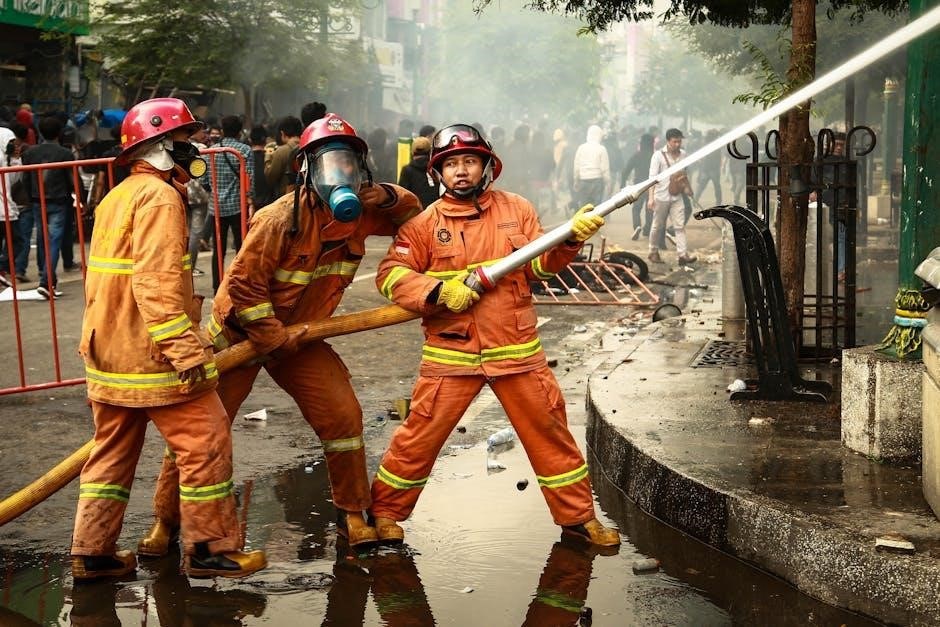nfpa 259 national fire protection association pdf
The National Fire Protection Association (NFPA) is a leader in fire protection and life safety. It develops standards like NFPA 259 to ensure fire safety engineering excellence.
Overview of the NFPA and Its Role in Fire Safety
The National Fire Protection Association (NFPA) is a global leader in fire protection and life safety. Established to reduce fire risks‚ the NFPA develops standards‚ codes‚ and training programs. Its standards‚ like NFPA 259‚ provide critical guidelines for fire safety engineering‚ testing‚ and materials. By promoting best practices‚ the NFPA ensures safer buildings‚ equipment‚ and emergency responses. Professionals worldwide rely on NFPA standards to design and implement fire protection systems‚ making it a cornerstone of public safety and fire prevention efforts.
Importance of NFPA Standards in Fire Protection
NFPA standards are crucial for ensuring fire safety and protecting lives and property. They provide clear guidelines for fire prevention‚ detection‚ and suppression systems. NFPA 259 specifically offers a standardized method for testing building materials under high-temperature conditions‚ ensuring materials are fire-resistant and safe. Compliance with NFPA standards is often mandated by building codes‚ making them essential for architects‚ engineers‚ and manufacturers. These standards promote consistency‚ innovation‚ and reliability in fire protection‚ contributing to safer environments globally.
NFPA 259 is a standard by the National Fire Protection Association that provides guidelines for fire safety in building materials‚ available as a downloadable PDF.
Scope and Purpose of NFPA 259
NFPA 259 defines the methodology for evaluating the heat release rate of building materials exposed to high temperatures‚ crucial for assessing fire growth potential. Its scope includes standardized test procedures to measure heat release rates‚ ensuring materials meet fire safety criteria. The purpose is to provide reliable data for fire safety engineering‚ aiding in material selection and ensuring compliance with fire codes‚ ultimately enhancing building safety and protecting occupants from fire hazards.
Key Components of the NFPA 259 Standard
The NFPA 259 standard outlines specific test methods and criteria for evaluating building materials’ fire performance. Key components include the use of a cone calorimeter to measure heat release rates‚ total heat released‚ and smoke production. The standard also specifies test specimen preparation‚ calibration procedures‚ and data interpretation. It ensures consistent and reliable results‚ enabling fire safety engineers to assess material behavior under fire conditions. These components are essential for determining how materials contribute to fire growth and spread‚ aiding in the selection of safer products for construction.
Importance of NFPA 259 in Fire Safety Engineering

NFPA 259 plays a crucial role in fire safety engineering by providing standardized methods to assess the fire performance of building materials. Its test procedures help engineers predict how materials will behave in real fire scenarios‚ enabling safer building designs. By measuring heat release and smoke production‚ the standard informs material selection and fire hazard assessments. This ensures compliance with fire safety codes and supports performance-based design approaches‚ ultimately reducing fire risks and protecting lives and property.

NFPA 259 Standard Test Method
NFPA 259 provides a standardized test method to evaluate the heat release rate of building materials under controlled fire conditions‚ ensuring accurate fire safety assessments.
Test Method for Determining Potential Heat of Building Materials

The NFPA 259 test method quantifies the potential heat released by building materials during combustion‚ providing critical data for fire safety assessments. Conducted in controlled conditions‚ the test measures heat release rates using advanced calorimetry techniques. By exposing materials to specific ignition sources‚ the method evaluates their contribution to fire growth and intensity. The results help determine the fire hazard potential of materials‚ aiding in the design of safer buildings and compliance with fire safety regulations. This data is essential for engineers and manufacturers to ensure materials meet fire performance standards.
Controlled Laboratory Conditions for Testing
Controlled laboratory conditions are essential for conducting NFPA 259 tests to ensure accuracy and reliability. The testing environment is meticulously regulated‚ with precise control over temperature‚ humidity‚ and airflow. Specialized equipment‚ such as calorimeters‚ is used to measure heat release rates and thermal properties of materials. These conditions minimize external variables‚ allowing for consistent and repeatable results. The controlled setup ensures that the data reflects the material’s true fire behavior‚ providing a reliable basis for fire safety assessments and engineering decisions.
High-Temperature Exposure in Fire Tests
High-temperature exposure is a critical aspect of NFPA 259 fire tests‚ simulating extreme fire conditions to evaluate material performance. The standard specifies rigorous heat flux levels‚ ensuring materials are subjected to intense thermal stress. This exposure helps determine how materials behave under fire‚ including ignition‚ decomposition‚ and heat release. The data collected is vital for assessing fire hazards and informing safety designs. By replicating real-world fire scenarios‚ NFPA 259 ensures materials meet stringent safety criteria‚ aiding engineers in creating fire-resistant structures.

2023 Edition of NFPA 259
The 2023 edition introduces enhanced clarity‚ updated test methods‚ and alignment with modern fire safety practices‚ ensuring improved accuracy and applicability in material evaluation.
Updates and Changes in the 2023 Edition
The 2023 edition of NFPA 259 includes revised test methods‚ updated definitions‚ and clarified procedures to enhance precision and accuracy. New annex sections provide expanded guidance on interpreting test results‚ addressing material variability. The standard now aligns more closely with international fire safety practices‚ ensuring harmonization and broader applicability. Additionally‚ updates reflect advancements in technology and materials science‚ offering improved tools for fire safety engineers and researchers. These changes aim to strengthen the reliability of potential heat measurements‚ ensuring safer building material selections and compliance with modern fire safety codes.
Annex B Revisions and Reference Document Updates
The 2023 edition of NFPA 259 includes significant updates to Annex B‚ which now incorporates additional examples and clarifications for calculating potential heat; New figures and tables have been added to improve understanding of test procedures. Reference documents have been updated to reflect current research and industry practices‚ ensuring alignment with the latest fire safety data. These revisions enhance the standard’s usability and provide clearer guidance for fire safety engineers and researchers‚ making Annex B a more comprehensive resource for interpreting test results and applying the standard effectively.

Applications of NFPA 259 in Fire Safety
NFPA 259 is crucial for fire test laboratories‚ manufacturers‚ and engineers to ensure materials meet safety standards‚ aiding in code compliance and fire-resistant designs.
Role in Fire Test Laboratories
NFPA 259 plays a vital role in fire test laboratories by providing standardized methods for evaluating the heat release and combustion properties of building materials. Laboratories use this standard to conduct precise tests‚ ensuring materials meet fire safety requirements. The controlled conditions outlined in NFPA 259 enable consistent and reliable test results‚ which are critical for assessing material performance in real-world fire scenarios. This standard is essential for laboratories to deliver accurate data‚ aiding in the development of fire-resistant materials and compliance with broader fire safety codes and regulations.
Use by Manufacturers and Fire Protection Engineers
NFPA 259 is widely used by manufacturers to ensure their materials meet fire safety standards‚ providing critical data for product development and certification. Fire protection engineers rely on the standard to assess material performance under fire conditions‚ enabling informed decisions in building design and system installation. This standard aids manufacturers in marketing fire-resistant products and helps engineers design safer structures‚ aligning with regulatory requirements and advancing fire safety practices.
Compliance with Fire Safety Codes and Best Practices
NFPA 259 plays a crucial role in ensuring materials comply with fire safety codes and best practices. By providing standardized test methods‚ it helps verify that building materials meet required safety performance criteria. This compliance is essential for designing safer structures and protecting occupants. The standard aligns with broader fire safety protocols‚ ensuring consistency and reliability in material evaluation. Adhering to NFPA 259 supports code compliance and serves as a reference for best practices in fire safety engineering‚ contributing to enhanced fire protection and life safety outcomes.

Obtaining the NFPA 259 PDF
The NFPA 259 PDF can be obtained through the official NFPA website. It is available for purchase or via subscription for digital access.
Downloading the Standard from the Official NFPA Website
To access the NFPA 259 standard‚ visit the official NFPA website. Navigate to the “Standards” section and search for “NFPA 259.” The document is available for purchase or through subscription. Once purchased‚ users can download the PDF directly from the website. The NFPA website ensures secure and instant access to the standard‚ with options for single-user or multi-user licenses. Digital formats allow for easy reference and searching within the document. Subscription plans also provide access to updates and revisions‚ ensuring compliance with the latest fire safety requirements.
Subscription and Access to NFPA Standards
Subscribing to NFPA standards provides unparalleled access to critical fire safety documents‚ including NFPA 259. The subscription service offers a convenient way to access the latest editions of standards‚ codes‚ and handbooks. Users can choose from individual or organizational plans‚ ensuring compliance with updated regulations. Subscriptions often include access to a digital library‚ allowing users to view and download multiple NFPA standards. This service is ideal for professionals who require frequent updates and comprehensive resources to stay informed about fire protection practices and standards.

Role of NFPA in Fire Protection and Life Safety
The NFPA plays a vital role in fire protection and life safety by developing and promoting codes and standards that safeguard people and property from fire risks‚ ensuring widespread adoption and compliance.
Impact of NFPA Standards on Building Codes
NFPA standards‚ including NFPA 259‚ significantly influence building codes by setting minimum requirements for fire safety in construction materials and designs. Authorities having jurisdiction often adopt these standards into local building codes‚ ensuring consistency and enhanced safety across regions. The integration of NFPA standards into building codes helps reduce fire hazards‚ protect lives‚ and safeguard property. Regular updates to NFPA standards ensure that building codes remain current with advancing technologies and emerging fire risks‚ fostering a safer built environment for occupants and communities alike.
Collaboration with Fire Researchers and Industry Experts
The NFPA actively collaborates with fire researchers‚ engineers‚ and industry experts to develop and refine standards like NFPA 259. This partnership ensures that the standards reflect the latest scientific advancements and practical field experiences. By engaging with experts‚ the NFPA incorporates innovative solutions and real-world insights into its guidelines. This collaborative approach fosters a comprehensive understanding of fire safety challenges and drives the creation of effective‚ widely adopted standards. Such teamwork strengthens the foundation of fire protection practices globally.

Comparison with Other NFPA Standards
NFPA 259 stands alongside standards like NFPA 251 and NFPA 703‚ each addressing unique aspects of fire safety‚ from material testing to fire resistance in construction.
NFPA 251: Standard Methods of Tests of Fire Resistance
NFPA 251 provides standardized methods for testing the fire resistance of materials and assemblies‚ ensuring they meet safety criteria in construction. It focuses on evaluating how components like walls‚ floors‚ and beams perform under fire exposure‚ providing critical data for fire safety engineering. Unlike NFPA 259‚ which measures heat release‚ NFPA 251 assesses resistance to fire penetration and structural integrity. This standard is essential for compliance with building codes and ensuring materials can withstand fire conditions‚ safeguarding lives and property. Its detailed test protocols ensure accuracy and reliability in fire resistance evaluations.
NFPA 703: Standard for Fire-Resistant Glazed Laboratory Windows
NFPA 703 establishes requirements for fire-resistant glazed windows in laboratory settings‚ ensuring they can withstand fire exposure while maintaining integrity. The standard includes test methods and criteria for evaluating windows under flame and thermal shock conditions. It addresses the unique risks in laboratories‚ where hazardous materials are often present. Compliance with NFPA 703 ensures windows can contain fires‚ prevent spread‚ and protect occupants. This standard is critical for maintaining fire safety in high-risk environments‚ providing reliable performance under extreme conditions.

Importance of NFPA 259 in Modern Construction
NFPA 259 provides standardized methods to evaluate building materials’ heat release‚ ensuring fire safety in construction. It aids in selecting materials that minimize fire intensity and spread‚ improving building design safety and compliance with fire codes. Regular updates reflect the latest fire science advancements‚ making it a crucial guideline for modern construction practices focused on safety and innovation.
Ensuring Fire Safety in Building Design
NFPA 259 plays a critical role in ensuring fire safety in building design by providing standardized test methods to evaluate the heat release of materials. This helps architects and engineers select materials that mitigate fire risks‚ creating safer environments. By measuring potential heat release‚ the standard identifies materials that reduce fire intensity and spread‚ aligning with modern fire safety goals. Its application in design ensures compliance with fire codes and promotes the use of materials that enhance occupant safety during fire incidents‚ making it indispensable in contemporary construction practices.
Material Selection and Compliance with Fire Standards
NFPA 259 provides critical guidelines for material selection and compliance with fire safety standards. The standard ensures that building materials are evaluated for their fire performance‚ including heat release and smoke production. This aids in identifying materials that meet fire safety requirements‚ reducing risks in construction projects. Compliance with NFPA 259 helps manufacturers and builders adhere to fire codes‚ ensuring safer environments. By standardizing material testing‚ NFPA 259 promotes consistency and reliability in fire safety practices across the construction industry.

